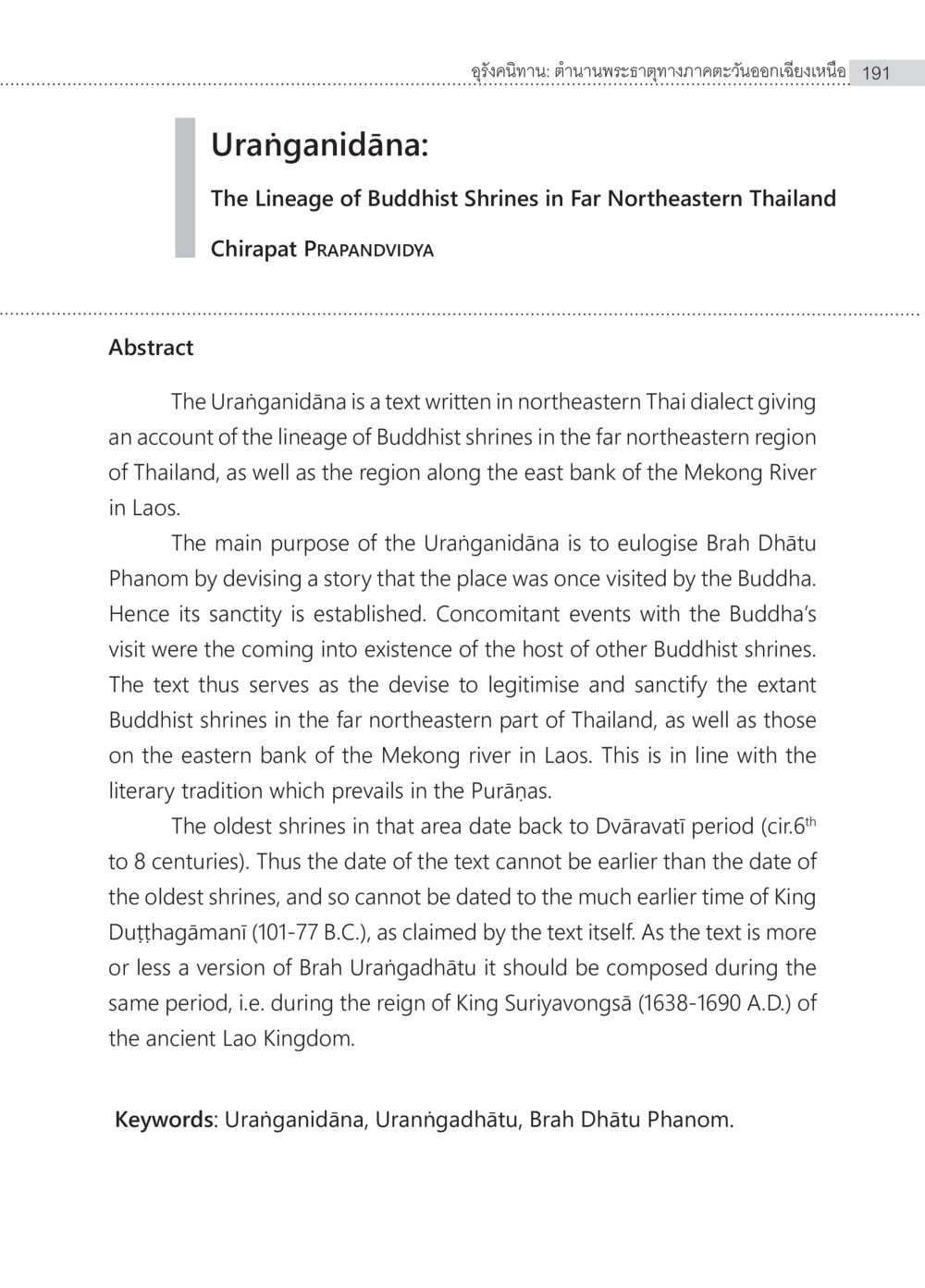อุรังคนีาน: ตำนานพระธาตุทางภาคตะวันออกเฉียงเหนือ : หน้า 3/19
อุรังคนิทาน ตำนานพระธาตุทางภาคตะวันออกเฉียงเหนือ : หน้า 3/19 การศึกษาเรื่องตำนานและความสำคัญของพระธาตุในภาคตะวันออกเฉียงเหนือของประเทศไทย
1 ครั้ง

สรุปเนื้อหา
อุรังคนีานเป็นเอกสารที่บรรยายถึงตำนานพระธาตุในภาคตะวันออกเฉียงเหนือของประเทศไทย รวมถึงพื้นที่ฝั่งตะวันออกของแม่น้ำโขงในลาว โดยมีจุดประสงค์หลักคือการยกย่องบราวะ Dhatū Phanom และสร้างเรื่องเล่าที่ว่าพระพุทธเจ้าเคยเสด็จมาที่ห้องนี้ เพื่อตั้งความศักดิ์สิทธิ์และเป็นการสร้างความถูกต้องให้กับพระธาตุต่างๆ ในพื้นที่นี้ โดยเนื้อหานี้สอดคล้องกับประเพณีทางวรรณกรรมที่พบในปราณา ตำนานพระธาตุที่เก่าแก่ที่สุดในพื้นที่นี้กลับไปถึงสมัยดวระวตี (ประมาณศตวรรษที่ 6 ถึง 8) ซึ่งหมายความว่าเอกสารนี้มีอายุไม่น่าจะเก่ากว่าพระธาตุที่เก่าแก่ที่สุด และควรจะถูกจัดทำขึ้นในช่วงรัชสมัยของพระเจ้าอุรเซีย วงฆ์ (1638-1690) ของอาณาจักรลาวโบราณ
หัวข้อประเด็น
- การศึกษาตำนานพระธาตุ
- ศาสนาพุทธในภาคตะวันออกเฉียงเหนือ
- บทบาทของบราวะ Dhatū Phanom
- ประวัติศาสตร์พระธาตุในลาว
- วรรณกรรมปราณา
ข้อความต้นฉบับในหน้า
อุรังคนีาน: ตำนานพระธาตุทางภาคตะวันออกเฉียงเหนือ 191
Urāṅganidāna:
The Lineage of Buddhist Shrines in Far Northeastern Thailand
Chirapat PRAPANDVIDYA
Abstract
The Urāṅganidāna is a text written in northeastern Thai dialect giving an account of the lineage of Buddhist shrines in the far northeastern region of Thailand, as well as the region along the east bank of the Mekong River in Laos.
The main purpose of the Urāṅganidāna is to eulogise Brah Dhatū Phanom by devising a story that the place was once visited by the Buddha. Hence its sanctity is established. Concomitant events with the Buddha’s visit were the coming into existence of the host of other Buddhist shrines. The text thus serves as the devise to legitimise and sanctify the extant Buddhist shrines in the far northeastern part of Thailand, as well as those on the eastern bank of the Mekong river in Laos. This is in line with the literary tradition which prevails in the Purānas.
The oldest shrines in that area date back to Dvāravāti period (cir. 6th to 8 centuries). Thus the date of the text cannot be earlier than the date of the oldest shrines, and so cannot be dated to the much earlier time of King Dutthagāmanī (101-77 B.C.), as claimed by the text itself. As the text is more or less a version of Brah Uraṅgadāhtu it should be composed during the same period, i.e., during the reign of King Suriyavongsā (1638-1690 A.D.) of the ancient Lao Kingdom.
Keywords: Urāṅganidāna, Uraṅgadāhu, Brah Dhatū Phanom.
หนังสือที่เกี่ยวข้อง
Load More



















